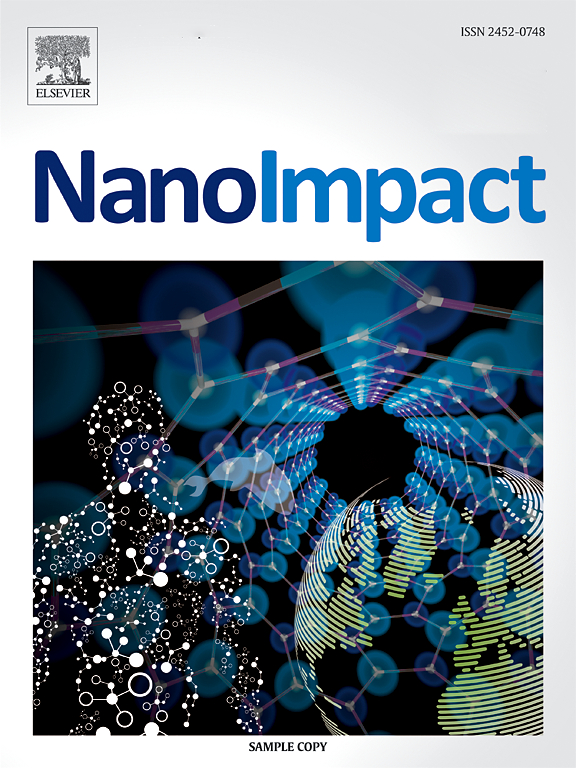微调协议的精确研究纳米颗粒粘附和吸收后叶面沉积。
IF 5.5
3区 环境科学与生态学
Q2 ENVIRONMENTAL SCIENCES
引用次数: 0
摘要
了解植物叶片与纳米颗粒(NPs)之间的相互作用对于促进植物保护产品的环境和安全性至关重要。近年来的研究表明,植物表面NPs的命运受NP性质、植物表面和环境因素的影响。然而,暴露叶片和测量NPs吸收的方法不一致,阻碍了研究的可重复性和可比性。这项工作研究了暴露和冲洗方案如何影响NPs剂量控制、分布和叶片表面元素的再活化。测试了文献中常用的四种暴露方法:滴滴沉积、喷涂、浸渍和刷涂。使用稀释乙醇(EtOH)、硝酸(HNO3)和超纯水(UPW)评估顺序冲洗策略。采用金(Au)和氧化铜(CuO) NPs作为溶解度对比模型。这些方案在番茄叶片(Solanum lycopersicum var. micro-tom)上进行了评估。结果表明,滴滴沉积产生的NPs剂量最一致,而其他方法则在剂量、覆盖范围和聚集性方面存在差异。在漂洗方案方面,HNO3-2 %可有效地漂洗CuO NPs,而EtOH-3 %的漂洗不能重新调动Cu,表明CuO NPs在叶片表面的附着性很强。相反,金纳米粒子用乙醇基溶剂清洗效果更好,这可能是由于溶剂极性低、表面张力降低和/或蜡破坏。这些发现强调了暴露和冲洗方法对实验结果的关键影响,以及它如何损害对叶片上NPs命运的解释。裁剪洗涤溶剂序列有助于探测np -叶片附着分数及其相互作用性质。此外,本研究提供了一个暴露和冲洗框架,以更好地解决具体的研究问题。本文章由计算机程序翻译,如有差异,请以英文原文为准。

Fine-tuning protocols for accurate study of nanoparticle adhesion and uptake after foliar deposition
Understanding the interactions between plant leaves and nanoparticles (NPs) is crucial for advancing both environmental and the safety of plant protection products. Recent studies showed how the fate of NPs on leaf surfaces is influenced by NP properties, plant surface, and environmental factors. Yet, inconsistent methods for exposing leaves and measuring NPs uptake hinder reproducibility and comparability across studies.
This work investigates how exposure and rinsing protocols affect NPs dose control, distribution, and element remobilization from leaf surfaces. Four exposure approaches commonly used in the literature were tested: drop-deposition, spraying, dipping, and brushing. Sequential rinsing strategies were evaluated using diluted ethanol (EtOH), diluted nitric acid (HNO3), and ultra-pure-water (UPW). Gold (Au) and copper oxide (CuO) NPs were used, as models presenting contrasting solubilities. These protocols were assessed on tomato leaves (Solanum lycopersicum var. micro-tom).
Results indicate that drop-deposition yielded the most consistent NPs dosing, while others introduced variability in dose, coverage and aggregation. Regarding rinsing protocols, CuO NPs, being more soluble, were efficiently rinsed by HNO3–2 %, whereas EtOH-3 % rinsing failed to remobilize Cu, indicating strong leaf attachment of CuO NPs to the leaf surface. Conversely, Au NPs were better rinsed with ethanol-based solvents, possibly due to solvent low polarity, lowered surface tension and/or wax disruption.
These findings underline the critical impacts of exposure and rinsing methods on experimental outcomes, and how it could impair the interpretation of the fate of NPs on leaves. Tailoring rinsing solvent sequences can contribute to probe NP-leaf attachment fractions and their interaction nature. Further, this study provides an exposure and rinsing framework to better tackle specific research questions.
求助全文
通过发布文献求助,成功后即可免费获取论文全文。
去求助
来源期刊

NanoImpact
Social Sciences-Safety Research
CiteScore
11.00
自引率
6.10%
发文量
69
审稿时长
23 days
期刊介绍:
NanoImpact is a multidisciplinary journal that focuses on nanosafety research and areas related to the impacts of manufactured nanomaterials on human and environmental systems and the behavior of nanomaterials in these systems.
 求助内容:
求助内容: 应助结果提醒方式:
应助结果提醒方式:


